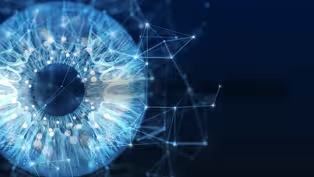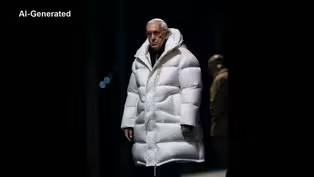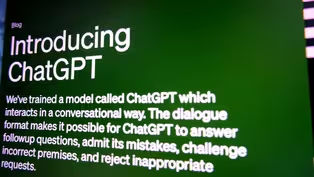
The Birth of Artificial Intelligence
Clip: Season 51 Episode 5 | 3m 24sVideo has Closed Captions
The origins of modern AI can be traced back to World War II.
Artificial intelligence might seem like something new but human beings have wondered for a very long time: can machines think like humans?
Problems playing video? | Closed Captioning Feedback
Problems playing video? | Closed Captioning Feedback
National Corporate funding for NOVA is provided by Carlisle Companies and Viking Cruises. Major funding for NOVA is provided by the NOVA Science Trust, the Corporation for Public Broadcasting, and PBS viewers.

The Birth of Artificial Intelligence
Clip: Season 51 Episode 5 | 3m 24sVideo has Closed Captions
Artificial intelligence might seem like something new but human beings have wondered for a very long time: can machines think like humans?
Problems playing video? | Closed Captioning Feedback
How to Watch NOVA
NOVA is available to stream on pbs.org and the free PBS App, available on iPhone, Apple TV, Android TV, Android smartphones, Amazon Fire TV, Amazon Fire Tablet, Roku, Samsung Smart TV, and Vizio.
Buy Now

NOVA Labs
NOVA Labs is a free digital platform that engages teens and lifelong learners in games and interactives that foster authentic scientific exploration. Participants take part in real-world investigations by visualizing, analyzing, and playing with the same data that scientists use.Providing Support for PBS.org
Learn Moreabout PBS online sponsorship- [Narrator] The modern origins of artificial intelligence can be traced back to World War II and the prodigious human brain of Alan Turing.
The legendary British mathematician developed a machine capable of deciphering coded messages from the Nazis.
After the war, he was among the first to predict computers might one day match the human brain.
There are no surviving recordings of Turing's voice, but in 1951, he gave a short lecture on BBC Radio.
We asked an AI generated voice to read a passage.
- [AI Voice] I think it is probable for instance that at the end of the century, it'll be possible to program a machine to answer questions in such a way that it will be extremely difficult to guess whether the answers are being given by a man or by the machine.
- [Narrator] And so the Turing test was born.
Could anyone build a machine that could converse with a human in a way that is indistinguishable from another person?
In 1956, a group of pioneering scientists spent the summer brainstorming at Dartmouth College.
- And they told the world that they have coined a new academic field of study.
They called it artificial intelligence.
- [Narrator] For decades, their aspirations remained far ahead of the capabilities of computers.
At the time, researchers were developing expert systems, purpose built to perform specific tasks.
- And so the the thing that we need to do to make machine understand, you know, our world is to put all our knowledge into a machine and then provide it with some rules.
- [Narrator] Classic AI reached a pivotal moment in 1997 when an artificial intelligence program devised by IBM called Deep Blue, defeated world chess champion and Grandmaster, Gary Kasparov.
It searched about 200 million positions a second, navigating through a tree of possibilities to determine the best move.
- The program analyzed the board configuration, could project forward millions of moves to examine millions of possibilities, and then picked the best path.
- [Narrator] Effective, but brittle, Deep Blue wasn't strategizing as a human does.
From the outset, artificial intelligence researchers imagined making machines that think like us.
The human brain with more than 80 billion neurons learns not by following rules, but rather by taking in a steady stream of data and looking for patterns.
- The way that learning actually works in the human brain is by updating the weights of the synaptic connections that are underlying this neural network.
So we have trillions of parameters in our brain that we can adjust based on experience.
I'm getting a reward, I will update the strength of the connections that led to this reward.
I'm getting punished, I will diminish the strength of the connections that led to the punishment.
So this is the original neural network.
We did not invent it, we, you know, we inherited it.
Video has Closed Captions
Preview: S51 Ep5 | 26s | Explore the promise and perils of new A.I. technologies. (26s)
How A.I. is fighting wildfires
Video has Closed Captions
Clip: S51 Ep5 | 1m 34s | Firefighters are using AI to find wildfires before they explode. (1m 34s)
How Deepfakes Manipulate Reality
Video has Closed Captions
Clip: S51 Ep5 | 4m 22s | Deepfakes are getting more convincing and easier to make. (4m 22s)
How Large Language Models Like ChatGPT Work
Video has Closed Captions
Clip: S51 Ep5 | 1m 44s | It’s not always easy to tell the difference between writing by a human and ChatGPT. (1m 44s)
Providing Support for PBS.org
Learn Moreabout PBS online sponsorship
- Science and Nature

Capturing the splendor of the natural world, from the African plains to the Antarctic ice.

- Science and Nature

Learn how centuries of knowledge helped our ancestors understand the mysteries of space.












Support for PBS provided by:
National Corporate funding for NOVA is provided by Carlisle Companies and Viking Cruises. Major funding for NOVA is provided by the NOVA Science Trust, the Corporation for Public Broadcasting, and PBS viewers.





